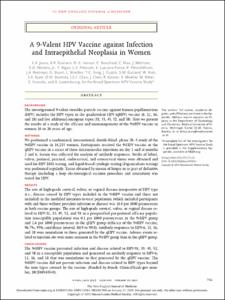KUMEL Repository
1. Journal Papers (연구논문)
1. School of Medicine (의과대학)
Dept. of Obstetrics & Gynecology (산부인과학)
A 9-Valent HPV Vaccine against Infection and Intraepithelial Neoplasia in Women
- Keimyung Author(s)
- Cho, Chi Heum
- Department
- Dept. of Obstetrics & Gynecology (산부인과학)
- Journal Title
- New England Journal of Medicine
- Issued Date
- 2015
- Volume
- 372
- Issue
- 8
- Abstract
- BACKGROUND
The investigational 9-valent viruslike particle vaccine against human papillomavirus
(HPV) includes the HPV types in the quadrivalent HPV (qHPV) vaccine (6, 11, 16,
and 18) and five additional oncogenic types (31, 33, 45, 52, and 58). Here we present
the results of a study of the efficacy and immunogenicity of the 9vHPV vaccine in
women 16 to 26 years of age.
METHODS
We performed a randomized, international, double-blind, phase 2b–3 study of the
9vHPV vaccine in 14,215 women. Participants received the 9vHPV vaccine or the
qHPV vaccine in a series of three intramuscular injections on day 1 and at months
2 and 6. Serum was collected for analysis of antibody responses. Swabs of labial,
vulvar, perineal, perianal, endocervical, and ectocervical tissue were obtained and
used for HPV DNA testing, and liquid-based cytologic testing (Papanicolaou testing)
was performed regularly. Tissue obtained by means of biopsy or as part of definitive
therapy (including a loop electrosurgical excision procedure and conization) was
tested for HPV.
RESULTS
The rate of high-grade cervical, vulvar, or vaginal disease irrespective of HPV type
(i.e., disease caused by HPV types included in the 9vHPV vaccine and those not
included) in the modified intention-to-treat population (which included participants
with and those without prevalent infection or disease) was 14.0 per 1000 person-years
in both vaccine groups. The rate of high-grade cervical, vulvar, or vaginal disease re-
lated to HPV-31, 33, 45, 52, and 58 in a prespecified per-protocol efficacy popula-
tion (susceptible population) was 0.1 per 1000 person-years in the 9vHPV group
and 1.6 per 1000 person-years in the qHPV group (efficacy of the 9vHPV vaccine,
96.7%; 95% confidence interval, 80.9 to 99.8). Antibody responses to HPV-6, 11, 16,
and 18 were noninferior to those generated by the qHPV vaccine. Adverse events re-
lated to injection site were more common in the 9vHPV group than in the qHPV group.
CONCLUSIONS
The 9vHPV vaccine prevented infection and disease related to HPV-31, 33, 45, 52,
and 58 in a susceptible population and generated an antibody response to HPV-6,
11, 16, and 18 that was noninferior to that generated by the qHPV vaccine. The
9vHPV vaccine did not prevent infection and disease related to HPV types beyond
the nine types covered by the vaccine. (Funded by Merck; ClinicalTrials.gov num-
ber, NCT00543543).
- Keimyung Author(s)(Kor)
- 조치흠
- Publisher
- School of Medicine
- Citation
- E.A. Joura et al. (2015). A 9-Valent HPV Vaccine against Infection and Intraepithelial Neoplasia in Women. New England Journal of Medicine, 372(8), 711–723. doi: 10.1056/NEJMoa1405044
- Type
- Article
- ISSN
- 0028-4793
- Appears in Collections:
- 1. School of Medicine (의과대학) > Dept. of Obstetrics & Gynecology (산부인과학)
- 파일 목록
-
-
Download
 oak-aaa-4786.pdf
기타 데이터 / 488.45 kB / Adobe PDF
oak-aaa-4786.pdf
기타 데이터 / 488.45 kB / Adobe PDF
-
Items in Repository are protected by copyright, with all rights reserved, unless otherwise indicated.